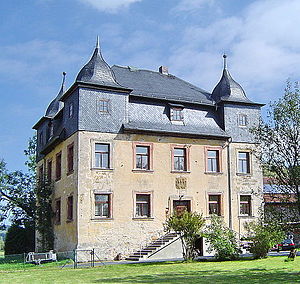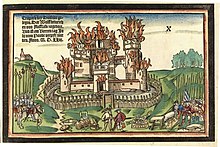Truppach Castle
| Truppach Castle | ||
|---|---|---|
|
The castle built after 1523 |
||
| Alternative name (s): | Truppach Castle | |
| Creation time : | First mentioned in 1380 | |
| Castle type : | Niederungsburg | |
| Conservation status: | no parts of the original castle have survived | |
| Standing position : | Imperial Knighthood | |
| Place: | Mistelgau- Truppach | |
| Geographical location | 49 ° 54 '29.6 " N , 11 ° 22' 24.9" E | |
| Height: | 377 m above sea level NN | |
|
|
||
The castle Truppach is a moated castle and a present-day castle in the district Truppach the community Mistelgau in the Bavarian district of Bayreuth .
history
The von Truppach family was recorded as early as 1059 (as "de Trubaha"). She is considered a follower of the Walpoten and from her a lower aristocratic class of imperial free ministerials later emerged. In the Landbuch des Amt Bayreuth from 1499 two aristocratic residences are mentioned for the small town Truppach: One belonged to the von Aufseß family , the other, verifiably , belonged to the von Truppach family since 1380. The latter was given up a little later and Klaus von Truppach moved to Alladorf . The von Truppach family was part of the imperial knighthood and was organized in the knight canton of Gebürg . It died out in 1550.
It is also known that as early as 1380 the Wasserburg zu Truppach, named after the Truppach brook, was owned by Conrad the Elder zu Christanz from the house of Groß von Trockau .
The fateful year 1523
In the middle of the 16th century, the robber baron Hans Thomas von Absberg kidnapped merchants from imperial cities in Franconia and Swabia on their trade trips and demanded a large ransom for their release. In order to reduce the growing risk of capture by troops of the Swabian Federation , he looked for allies who would support him in his raids and hide his prisoners in their castles in case of danger. Wolf Heinrich von Aufseß was one of them. In 1523 the federal government sent its troops to level a total of 23 predatory nests to the ground. The federal troops, which consisted of 10,000 foot soldiers and 1,000 horsemen, carried 100 cannons , 30 rifles and 900 quintals of black powder as armament. On July 4th they reached Truppach Castle and blew it up to prevent those from Truppach from returning.
The centuries after that
With the help of the Bishop of Bamberg , who approved the construction timber, the castle could be rebuilt a little later. Friedrich von Vietinghoff acquired the castle in 1792 and had some minor changes made. In 1830 it fell into the hands of the von Aufseß family who, however, sold it to Johann Georg Brey ten years later. Nothing is known about the further history of the castle, as a later owner burned all records for reasons that are not clear. Today the castle is privately owned. The ground floor has been modernized and is inhabited. The stairwell and the first floor are largely in their original, but uninhabitable condition; the top floor is partially renovated and also uninhabited.
The woodcut by Hans Wandereisen
Main article: Wandereisen woodcuts from 1523
The Niederungsburg was protected by a palisade fence and a surrounding moat . A turret can be seen at each corner of the inner castle wall. The actual castle gate is relatively large and supports a small building. The Palas consists of several storeys. The bottom one has massive stone walls with only one window opening on the left side. The upper floors are built in half-timbered houses. A crowd of watchtowers can also be seen at every corner of the Palas . A tower in the middle of the roof has an unusually large opening like the Waldsteinburg . The keep is in the right half of the complex and can only be reached through a corridor from the hall. The upper part also consists of half-timbering. A machicolation can be seen on the right side . The federal troops of five horsemen on the left and a good 30 foot soldiers on the right have just cleared the castle and spread the found objects in front of the complex. A drummer and a senior officer examine the objects found in the middle. The Bund flag, actually red and white, is shown here in blue and white, which is probably due to incorrect coloring. A chapel can be seen in the upper left corner.
literature
- Hellmut Kunstmann : The castles of north-western and northern Franconian Switzerland . Reprint, Kommissionsverlag Degener & Co., Neustadt an der Aisch 2000, ISBN 3-7686-9265-5 , pp. 211-221.
- Karl Dietel's records in the Münchberg City Archives





